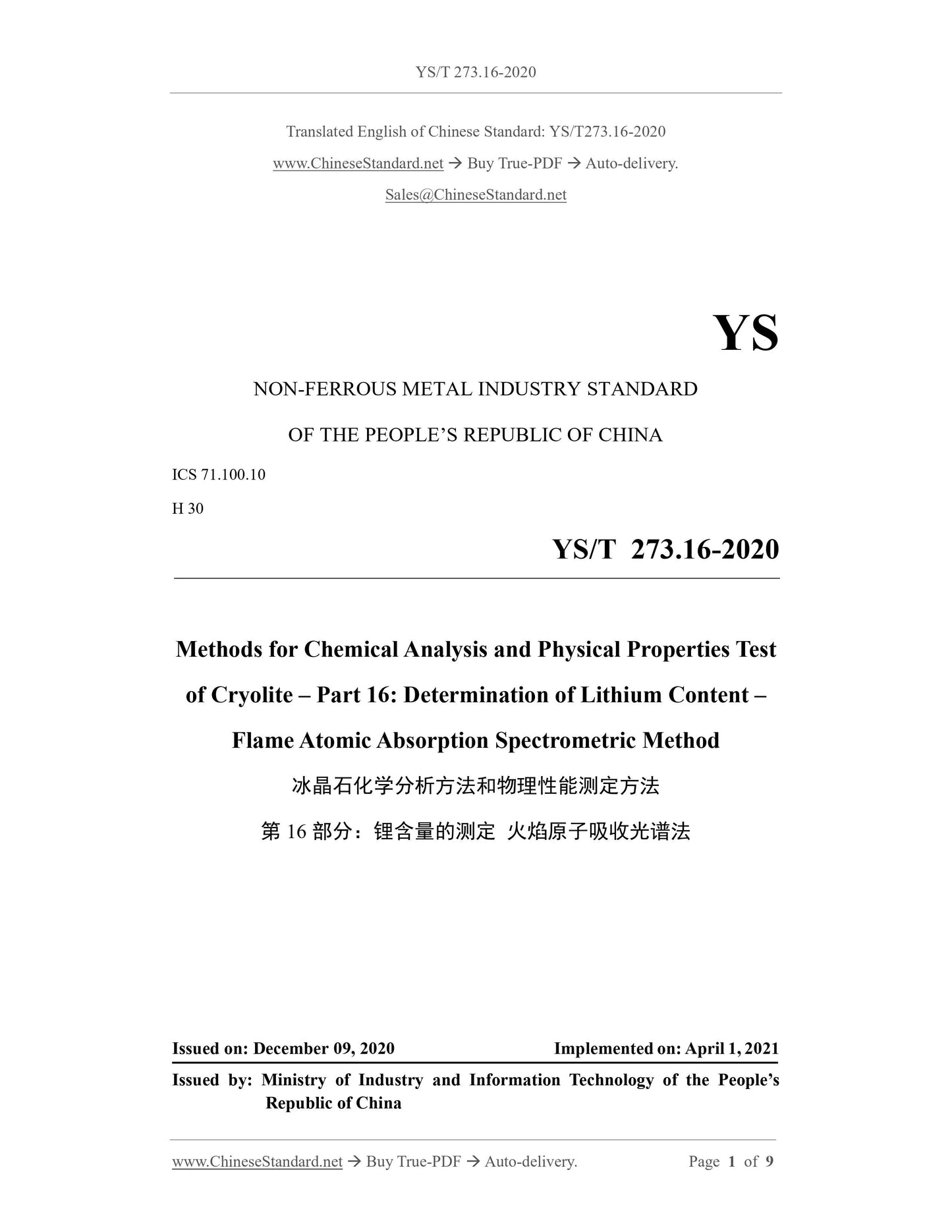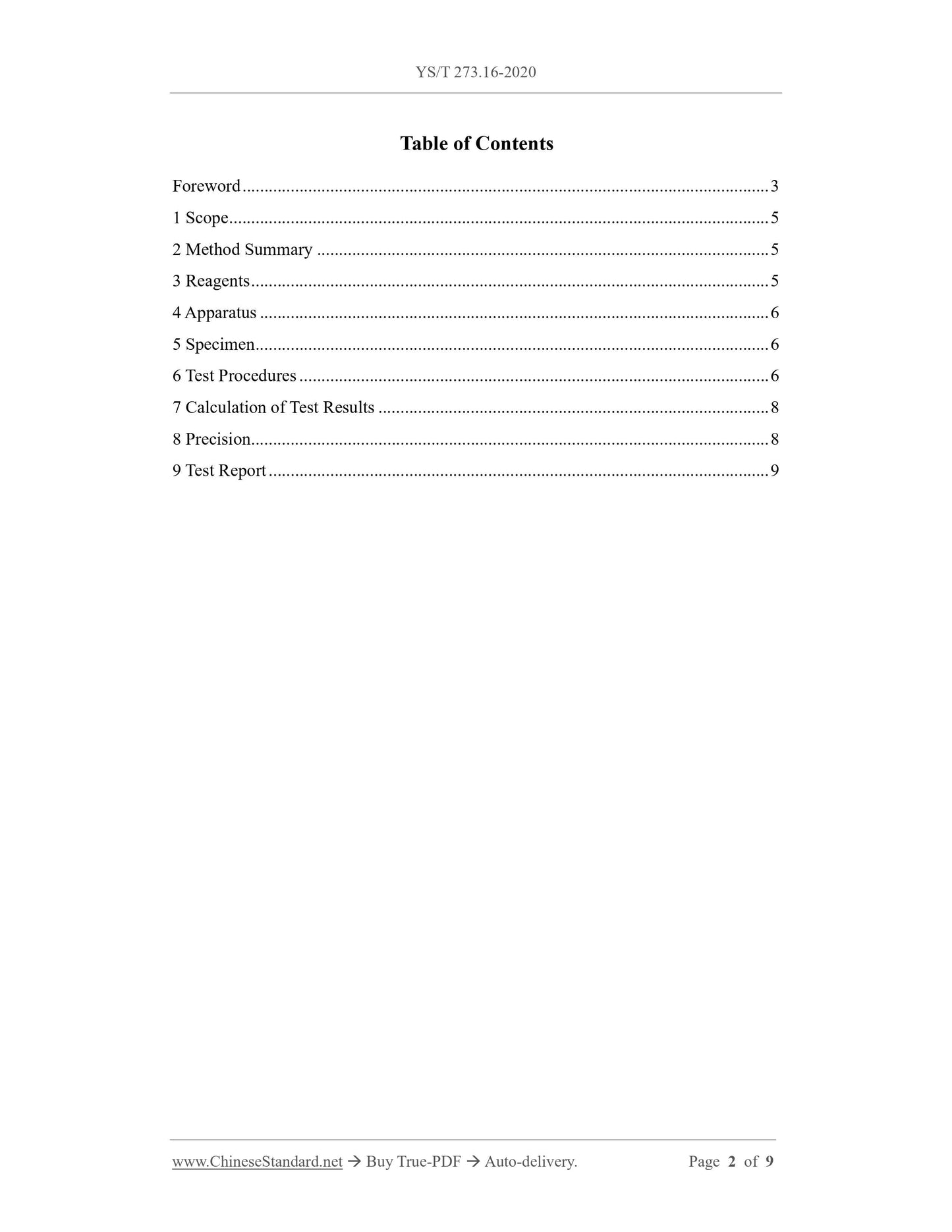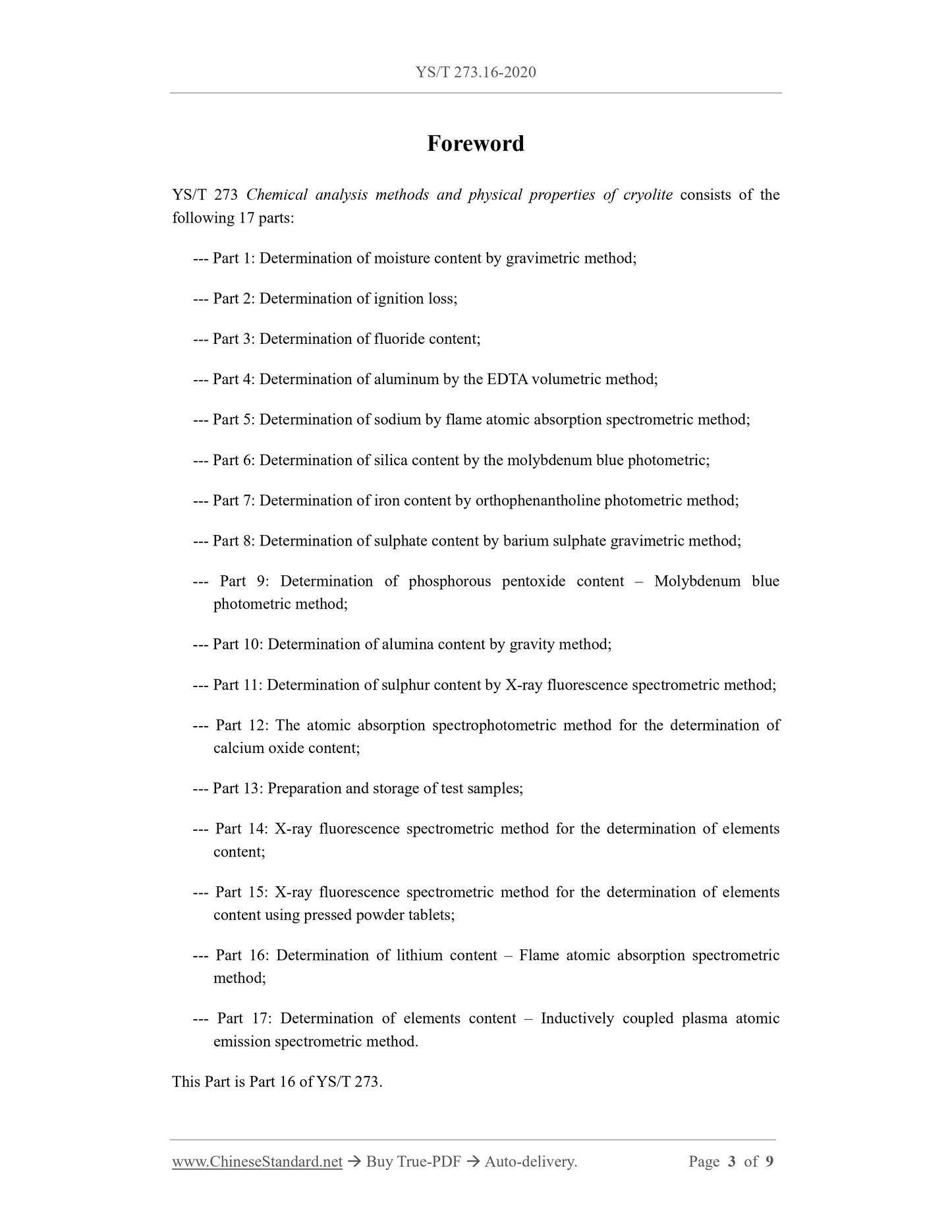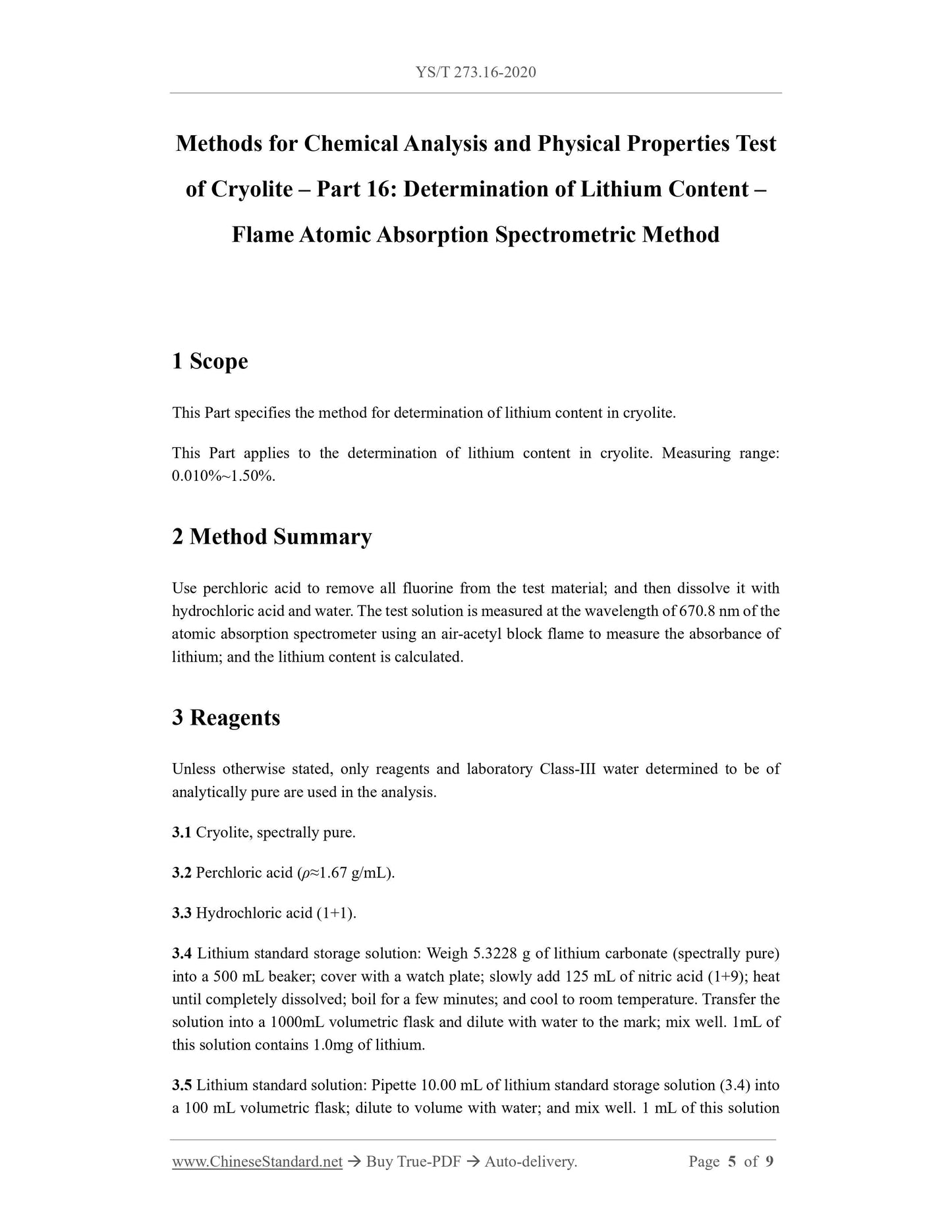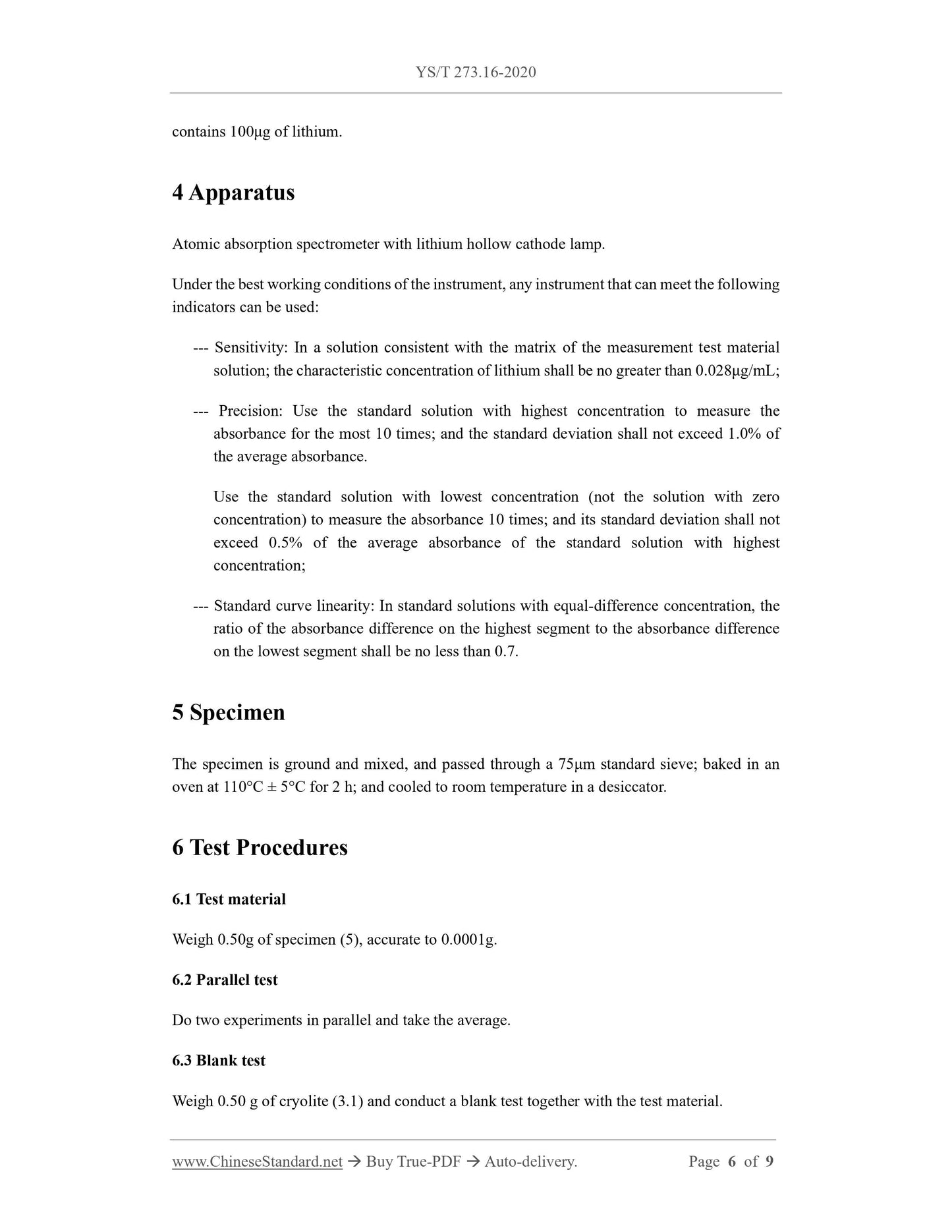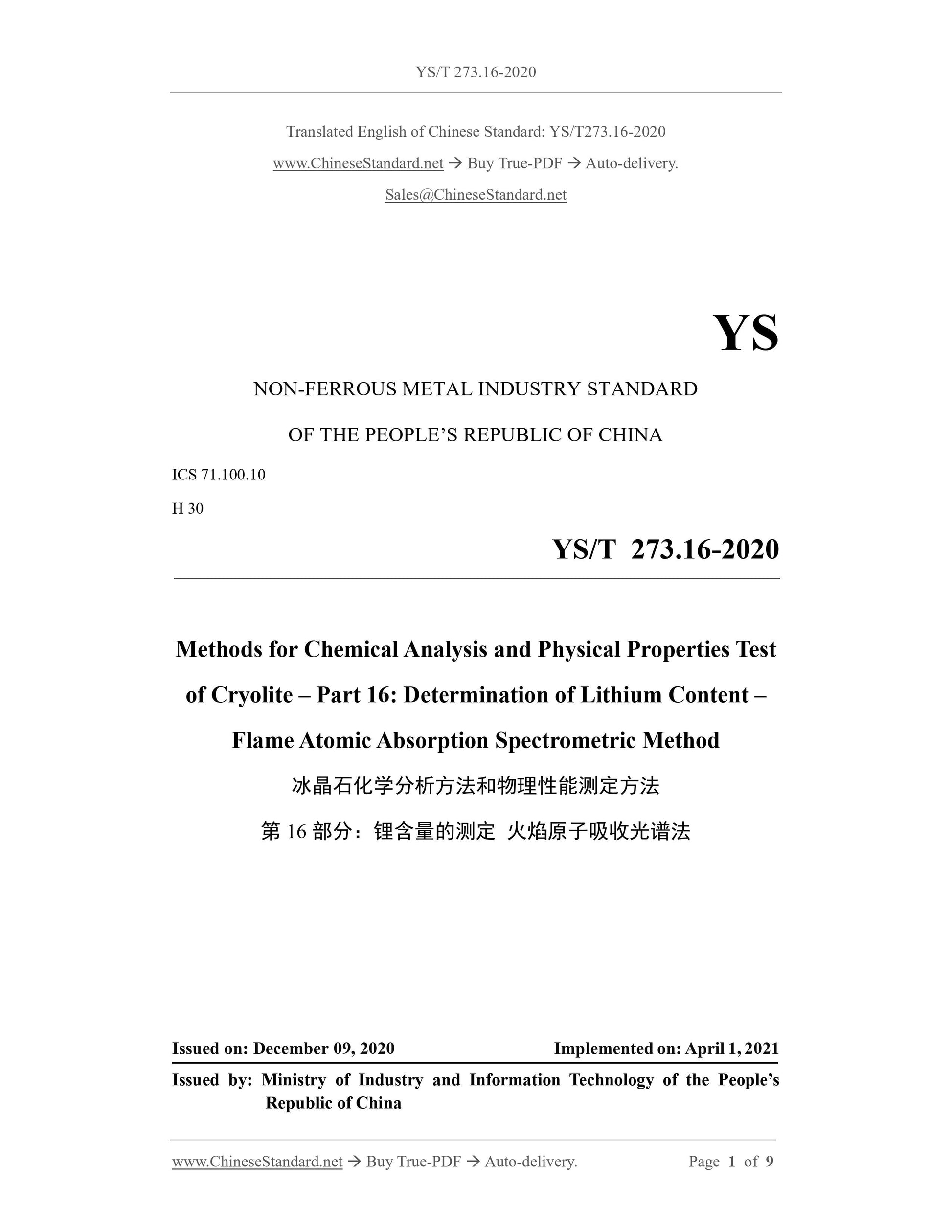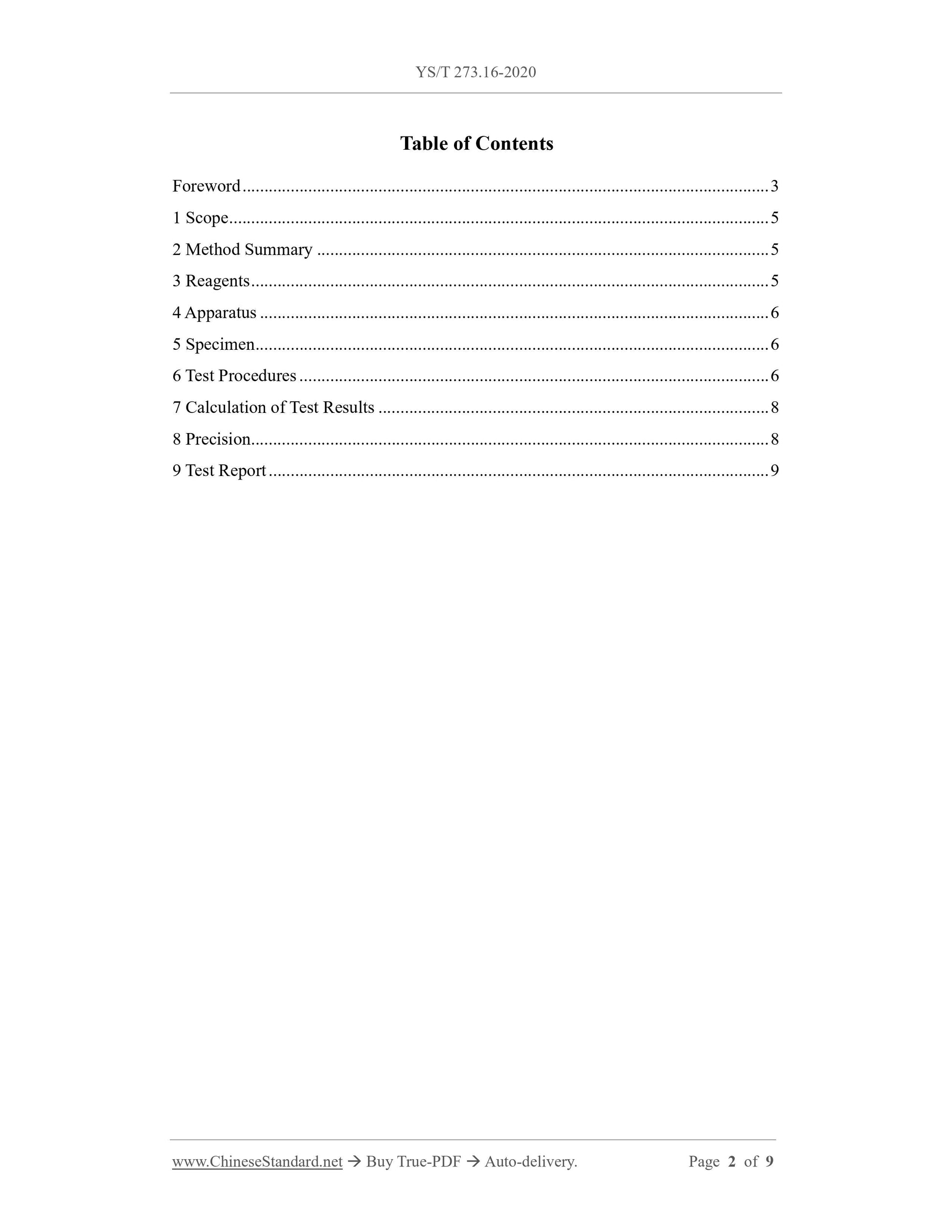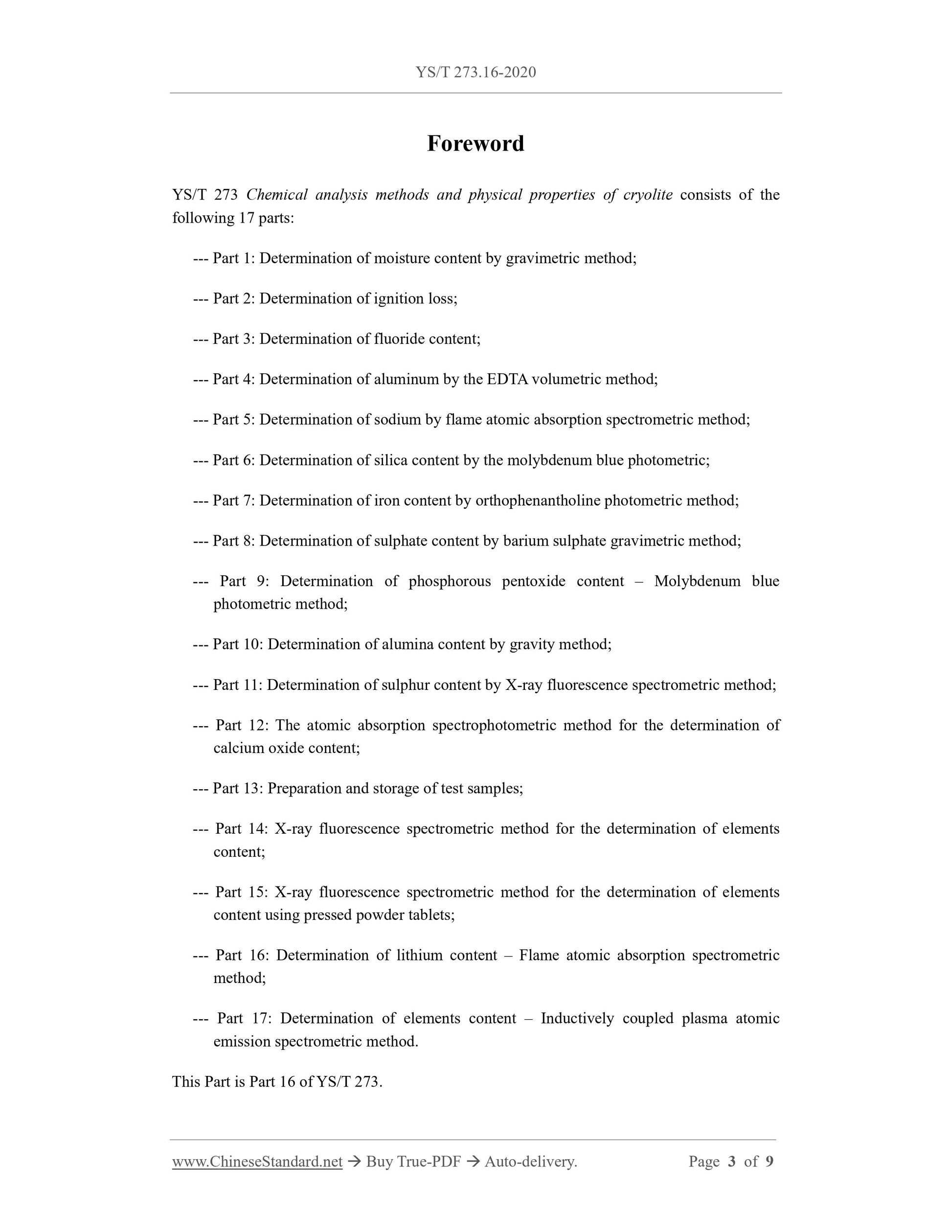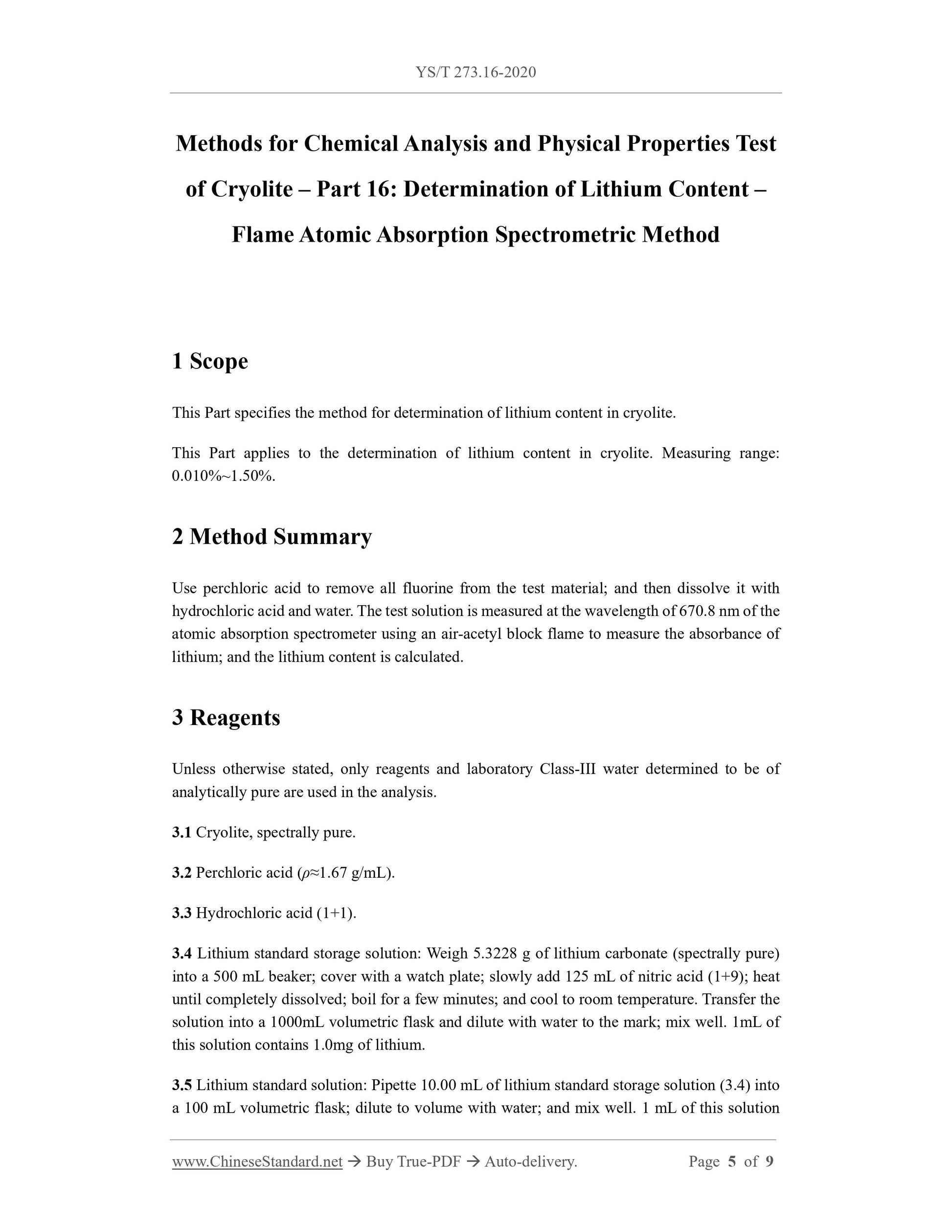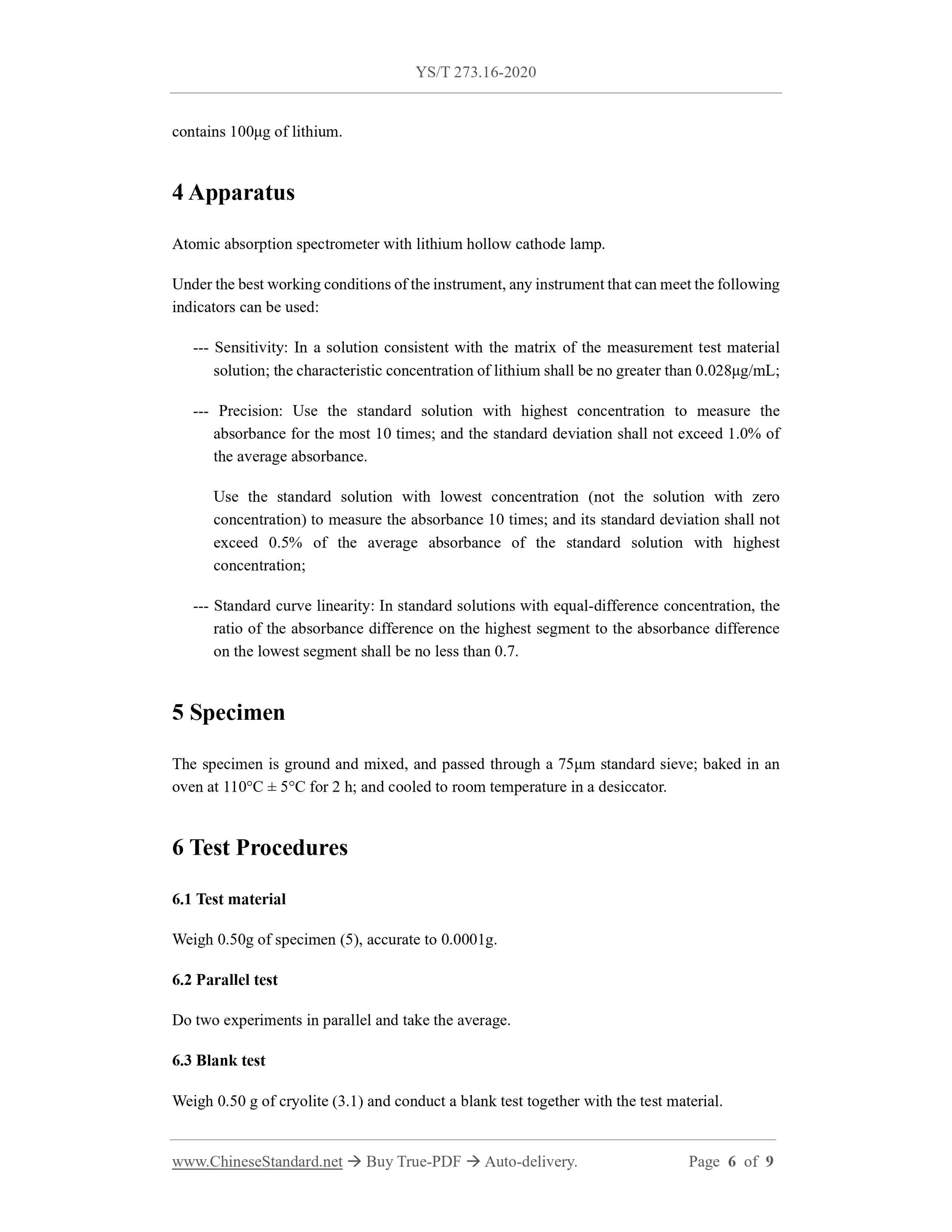PayPal, credit cards. Download editable-PDF and invoice in 1 second!
YS/T 273.16-2020 English PDF (YST273.16-2020)
YS/T 273.16-2020 English PDF (YST273.16-2020)
Precio habitual
$110.00 USD
Precio habitual
Precio de oferta
$110.00 USD
Precio unitario
/
por
Los gastos de envío se calculan en la pantalla de pago.
No se pudo cargar la disponibilidad de retiro
Delivery: 3 seconds. Download true-PDF + Invoice.
Get QUOTATION in 1-minute: Click YS/T 273.16-2020
Historical versions: YS/T 273.16-2020
Preview True-PDF (Reload/Scroll if blank)
YS/T 273.16-2020: Methods for chemical analysis and physical properties test of cryolite - Part 16: Determination of lithium content - Flame atomic absorption spectrometric method
YS/T 273.16-2020
YS
NON-FERROUS METAL INDUSTRY STANDARD
OF THE PEOPLE’S REPUBLIC OF CHINA
ICS 71.100.10
H 30
Methods for Chemical Analysis and Physical Properties Test
of Cryolite – Part 16: Determination of Lithium Content –
Flame Atomic Absorption Spectrometric Method
ISSUED ON: DECEMBER 09, 2020
IMPLEMENTED ON: APRIL 1, 2021
Issued by: Ministry of Industry and Information Technology of the People’s
Republic of China
Table of Contents
Foreword ... 3
1 Scope ... 5
2 Method Summary ... 5
3 Reagents ... 5
4 Apparatus ... 6
5 Specimen ... 6
6 Test Procedures ... 6
7 Calculation of Test Results ... 8
8 Precision ... 8
9 Test Report ... 9
Foreword
YS/T 273 Chemical analysis methods and physical properties of cryolite consists of the
following 17 parts:
--- Part 1: Determination of moisture content by gravimetric method;
--- Part 2: Determination of ignition loss;
--- Part 3: Determination of fluoride content;
--- Part 4: Determination of aluminum by the EDTA volumetric method;
--- Part 5: Determination of sodium by flame atomic absorption spectrometric method;
--- Part 6: Determination of silica content by the molybdenum blue photometric;
--- Part 7: Determination of iron content by orthophenantholine photometric method;
--- Part 8: Determination of sulphate content by barium sulphate gravimetric method;
--- Part 9: Determination of phosphorous pentoxide content – Molybdenum blue
photometric method;
--- Part 10: Determination of alumina content by gravity method;
--- Part 11: Determination of sulphur content by X-ray fluorescence spectrometric method;
--- Part 12: The atomic absorption spectrophotometric method for the determination of
calcium oxide content;
--- Part 13: Preparation and storage of test samples;
--- Part 14: X-ray fluorescence spectrometric method for the determination of elements
content;
--- Part 15: X-ray fluorescence spectrometric method for the determination of elements
content using pressed powder tablets;
--- Part 16: Determination of lithium content – Flame atomic absorption spectrometric
method;
--- Part 17: Determination of elements content – Inductively coupled plasma atomic
emission spectrometric method.
This Part is Part 16 of YS/T 273.
Methods for Chemical Analysis and Physical Properties Test
of Cryolite – Part 16: Determination of Lithium Content –
Flame Atomic Absorption Spectrometric Method
1 Scope
This Part specifies the method for determination of lithium content in cryolite.
This Part applies to the determination of lithium content in cryolite. Measuring range:
0.010%~1.50%.
2 Method Summary
Use perchloric acid to remove all fluorine from the test material; and then dissolve it with
hydrochloric acid and water. The test solution is measured at the wavelength of 670.8 nm of the
atomic absorption spectrometer using an air-acetyl block flame to measure the absorbance of
lithium; and the lithium content is calculated.
3 Reagents
Unless otherwise stated, only reagents and laboratory Class-III water determined to be of
analytically pure are used in the analysis.
3.1 Cryolite, spectrally pure.
3.2 Perchloric acid (ρ≈1.67 g/mL).
3.3 Hydrochloric acid (1+1).
3.4 Lithium standard storage solution: Weigh 5.3228 g of lithium carbonate (spectrally pure)
into a 500 mL beaker; cover with a watch plate; slowly add 125 mL of nitric acid (1+9); heat
until completely dissolved; boil for a few minutes; and cool to room temperature. Transfer the
solution into a 1000mL volumetric flask and dilute with water to the mark; mix well. 1mL of
this solution contains 1.0mg of lithium.
3.5 Lithium standard solution: Pipette 10.00 mL of lithium standard storage solution (3.4) into
a 100 mL volumetric flask; dilute to volume with water; and mix well. 1 mL of this solution
contains 100μg of lithium.
4 Apparatus
Atomic absorption spectrometer with lithium hollow cathode lamp.
Under the best working conditions of the instrument, any instrument that can meet the following
indicators can be used:
--- Sensitivity: In a solution consistent with the matrix of the measurement test material
solution; the characteristic concentration of lithium shall be no greater than 0.028μg/mL;
--- Precision: Use the standard solution with highest concentration to measure the
absorbance for the most 10 times; and the standard deviation shall not exceed 1.0% of
the average absorbance.
Use the standard solution with lowest concentration (not the solution with zero
concentration) to measure the absorbance 10 times; and its standard deviation shall not
exceed 0.5% of the average absorbance of the standard solution with highest
concentration;
--- Standard curve linearity: In standard solutions with equal-difference concentration, the
ratio of the absorbance difference on the highest segment to the absorbance difference
on the lowest segment shall be no less than 0.7.
5 Specimen
The specimen is ground and mixed, and passed through a 75μm standard sieve; baked in an
oven at 110°C ± 5°C for 2 h; and cooled to room temperature in a desiccator.
6 Test Procedures
6.1 Test material
Weigh 0.50g of specimen (5), accurate to 0.0001g.
6.2 Parallel test
Do two experiments in parallel and take the average.
6.3 Blank test
Weigh 0.50 g of cryolite (3.1) and conduct a blank test together with the test material.
Get QUOTATION in 1-minute: Click YS/T 273.16-2020
Historical versions: YS/T 273.16-2020
Preview True-PDF (Reload/Scroll if blank)
YS/T 273.16-2020: Methods for chemical analysis and physical properties test of cryolite - Part 16: Determination of lithium content - Flame atomic absorption spectrometric method
YS/T 273.16-2020
YS
NON-FERROUS METAL INDUSTRY STANDARD
OF THE PEOPLE’S REPUBLIC OF CHINA
ICS 71.100.10
H 30
Methods for Chemical Analysis and Physical Properties Test
of Cryolite – Part 16: Determination of Lithium Content –
Flame Atomic Absorption Spectrometric Method
ISSUED ON: DECEMBER 09, 2020
IMPLEMENTED ON: APRIL 1, 2021
Issued by: Ministry of Industry and Information Technology of the People’s
Republic of China
Table of Contents
Foreword ... 3
1 Scope ... 5
2 Method Summary ... 5
3 Reagents ... 5
4 Apparatus ... 6
5 Specimen ... 6
6 Test Procedures ... 6
7 Calculation of Test Results ... 8
8 Precision ... 8
9 Test Report ... 9
Foreword
YS/T 273 Chemical analysis methods and physical properties of cryolite consists of the
following 17 parts:
--- Part 1: Determination of moisture content by gravimetric method;
--- Part 2: Determination of ignition loss;
--- Part 3: Determination of fluoride content;
--- Part 4: Determination of aluminum by the EDTA volumetric method;
--- Part 5: Determination of sodium by flame atomic absorption spectrometric method;
--- Part 6: Determination of silica content by the molybdenum blue photometric;
--- Part 7: Determination of iron content by orthophenantholine photometric method;
--- Part 8: Determination of sulphate content by barium sulphate gravimetric method;
--- Part 9: Determination of phosphorous pentoxide content – Molybdenum blue
photometric method;
--- Part 10: Determination of alumina content by gravity method;
--- Part 11: Determination of sulphur content by X-ray fluorescence spectrometric method;
--- Part 12: The atomic absorption spectrophotometric method for the determination of
calcium oxide content;
--- Part 13: Preparation and storage of test samples;
--- Part 14: X-ray fluorescence spectrometric method for the determination of elements
content;
--- Part 15: X-ray fluorescence spectrometric method for the determination of elements
content using pressed powder tablets;
--- Part 16: Determination of lithium content – Flame atomic absorption spectrometric
method;
--- Part 17: Determination of elements content – Inductively coupled plasma atomic
emission spectrometric method.
This Part is Part 16 of YS/T 273.
Methods for Chemical Analysis and Physical Properties Test
of Cryolite – Part 16: Determination of Lithium Content –
Flame Atomic Absorption Spectrometric Method
1 Scope
This Part specifies the method for determination of lithium content in cryolite.
This Part applies to the determination of lithium content in cryolite. Measuring range:
0.010%~1.50%.
2 Method Summary
Use perchloric acid to remove all fluorine from the test material; and then dissolve it with
hydrochloric acid and water. The test solution is measured at the wavelength of 670.8 nm of the
atomic absorption spectrometer using an air-acetyl block flame to measure the absorbance of
lithium; and the lithium content is calculated.
3 Reagents
Unless otherwise stated, only reagents and laboratory Class-III water determined to be of
analytically pure are used in the analysis.
3.1 Cryolite, spectrally pure.
3.2 Perchloric acid (ρ≈1.67 g/mL).
3.3 Hydrochloric acid (1+1).
3.4 Lithium standard storage solution: Weigh 5.3228 g of lithium carbonate (spectrally pure)
into a 500 mL beaker; cover with a watch plate; slowly add 125 mL of nitric acid (1+9); heat
until completely dissolved; boil for a few minutes; and cool to room temperature. Transfer the
solution into a 1000mL volumetric flask and dilute with water to the mark; mix well. 1mL of
this solution contains 1.0mg of lithium.
3.5 Lithium standard solution: Pipette 10.00 mL of lithium standard storage solution (3.4) into
a 100 mL volumetric flask; dilute to volume with water; and mix well. 1 mL of this solution
contains 100μg of lithium.
4 Apparatus
Atomic absorption spectrometer with lithium hollow cathode lamp.
Under the best working conditions of the instrument, any instrument that can meet the following
indicators can be used:
--- Sensitivity: In a solution consistent with the matrix of the measurement test material
solution; the characteristic concentration of lithium shall be no greater than 0.028μg/mL;
--- Precision: Use the standard solution with highest concentration to measure the
absorbance for the most 10 times; and the standard deviation shall not exceed 1.0% of
the average absorbance.
Use the standard solution with lowest concentration (not the solution with zero
concentration) to measure the absorbance 10 times; and its standard deviation shall not
exceed 0.5% of the average absorbance of the standard solution with highest
concentration;
--- Standard curve linearity: In standard solutions with equal-difference concentration, the
ratio of the absorbance difference on the highest segment to the absorbance difference
on the lowest segment shall be no less than 0.7.
5 Specimen
The specimen is ground and mixed, and passed through a 75μm standard sieve; baked in an
oven at 110°C ± 5°C for 2 h; and cooled to room temperature in a desiccator.
6 Test Procedures
6.1 Test material
Weigh 0.50g of specimen (5), accurate to 0.0001g.
6.2 Parallel test
Do two experiments in parallel and take the average.
6.3 Blank test
Weigh 0.50 g of cryolite (3.1) and conduct a blank test together with the test material.
Share
